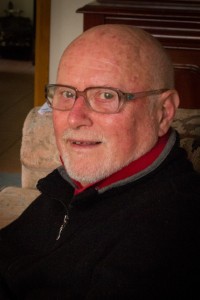Here you will find occasional posts and updates about my work and related subjects.
Launching ‘Shirley Smith: An Examined Life’
Shirley Smith was launched by the Hon. Grant Robertson at Unity Books, Wellington, on Monday 10 June. It was an honour to have Grant launch the book. He gave a great speech, pointing up the significance of Shirley Smith and her relevance in our lives today. My thanks to others who spoke and all who made the launch such a success, especially VUP and Unity Books who hosted the event. No wonder your readers love you!
May days
The month of May started for me in the Northern Hemisphere where it was all about spring, new life, a new grandson, family reunions and, as always, new research.
Back home in Lower Hutt, the magnolia cambellii has burst into flower unseasonably early. I don’t know what that means (other than climate change) but I’m taking it as a good sign.
The month has also rewarded me in other ways: the publication of Shirley Smith: An Examined Life, the wonderful Auckland Writers’ Festival, and some good early reviews.
Also, my entry on Shirley Smith for the on-line Dictionary of New Zealand Biography has just been published.
And, quite unrelated, the New Zealand Society of Authors’ podcast of my oral history interview with Alistair Te Ariki Campbell, recorded in 2004, had gone live. (Since then, NZSA have added my interviews with Ian Cross and Tony Simpson.)
My book launch for Shirley Smith is yet to come! to be launched by Hon Grant Robertson (he has to get his Wellbeing Budget out first) on 10 June, 6.00 to 7.30 at Unity Books, Wellington. All welcome!
Auckland Writers’ Festival
I’m delighted and deeply honoured to be chosen as the inaugural speaker for the Friends of the Turnbull Library in their proposed three-year sponsorship of an event at the AWF. I will be highlighting some of the many primary sources I used from the treasures held in the Turnbull Library. This is a FREE event.
Sunday 19 May, 11.30 – 12.30 p.m. Waitākere Room, Aotea Centre.
Publication!
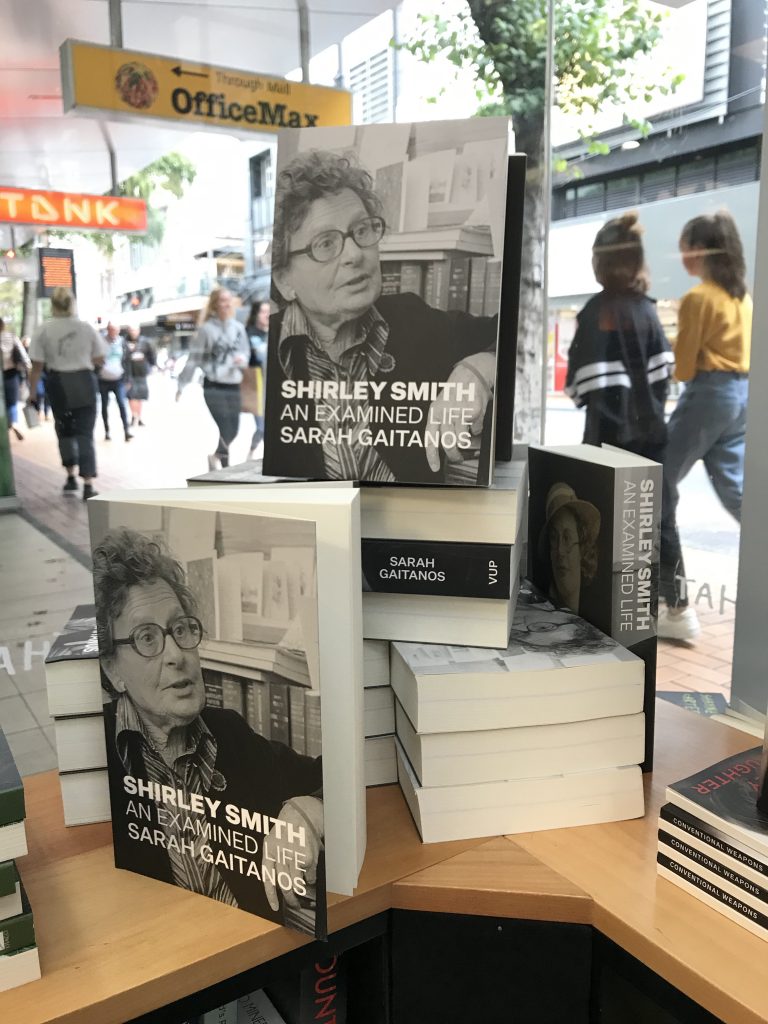
Unity Books will host the launch on Monday 10 June, 6.00 pm – 7.30 pm
to be launched by Hon. Grant Robertson
All welcome!
See review by Simon Nathan in Scoop Books.
They Are Us
After a lapse I intended to start writing posts again here, but I never imagined it would be prompted by the recent devastating event that has shaken New Zealanders everywhere. I wish to offer a heart-felt tribute to the victims of the terrorist attack on Muslims in Christchurch last week. As I write this, the first funerals are taking place. I join with those who feel for the families and community in their grief.
It’s hard to find the right words. We are fortunate that Prime Minister Jacinda Ardern has shown us the way, not only with her words and actions but by the empathy she so obviously feels for the Muslim community. Throughout the country and the world, people have embraced her message: They are us.
Expressions of love and inclusion take many forms: people turn up for vigils in unprecedented numbers, they lay flowers outside mosques, light candles, give money, write messages on murals, in tribute books, share on social media, contact friends and family far and wide and show kindness and love to those near and dear.
Through haka and karakia, Māori offer a powerful and healing expression of feeling. Music speaks to the heart, not only in the gatherings in support of the Muslim community but also on social media also. Dave Dobbyn’s song Welcome Home has been taken up by various groups, including the Orpheus Choir of Wellington. We recorded a video last night to share: https://youtu.be/k6LZe-AaSWw On Friday we take part in a free performance of The Armed Man: A Mass for Peace by Karl Jenkins, composed in 1999 for the victims of the Kosovo conflict. It includes a Muslim call to prayer alongside Christian, Hindu and other texts, with a karakia replacing the Last Post.
The message resounds. They are us.
Exhibition on Jewish Women
The Jewish Community in Szombathely has opened a new exhibition with special emphasis on women. I’m delighted to learn that The Violinist was a useful source. The sharing and recovery of the past continues. See the leaflet: leporello-elekt_eng
Róbert Balogh, who has translated the curator’s narrative and forthcoming album from Hungarian to English, sent me photos that historian Krisztina Kelbert located in the Savaria Museum of Szombathely. (I went there in 2008 but came away empty-handed!)
I found it particularly moving to see the happy face of young Klári in 1940 and the striking picture of her mother Zsuzsa (1941) that captures her warmth and wisdom. I’m only sad that Clare (Klári in her former life, before she came to New Zealand) did not live to see this. She struggled hard to remember her mother’s face. The third is Klári’s aunt, Rózsi Brill (1938), who survived the Holocaust and came to New Zealand with Clare. An earlier photo of Klári and Mihály shows they would rather be outside playing – or in Klári’s case, playing the violin! But it’s wonderful to have all these.
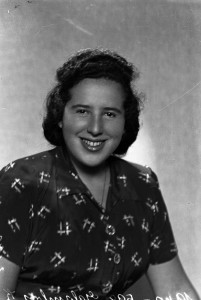
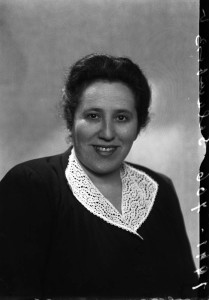
Horváth Lászlóné 2009
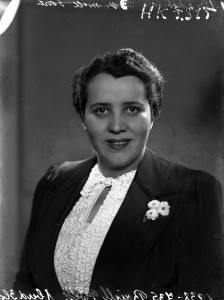
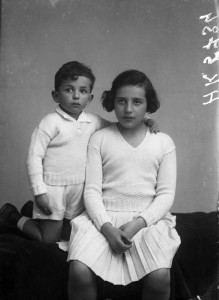
Clare’s story in Veszprém
On Tuesday 24 March The Violinist was ‘launched’ in Hungary with a public event held in Veszprém, hosted by the University of Pannonia and the Library of Veszprém County. This event was inspired by the article András Dési wrote in Népszabadság (see my previous post). András was invited to take part in the presentation. He sent me this account:
First, I have to say that I’m still under the emotional impact of the event.
It was very well organized, about 50-60 students of the University of Veszprém attended.
I can only appreciate the highest standards of the efforts of the organizers, Ms Eszter ADAM specialist at the Eötvös Károly County Library, Ms Boglárka FALUSSY, Director of the American Corner Veszprém and Ms Judit PALMANN, Director of the County Library. They really deserve all acknowledgement and honour.
The event began with music, two students played violin pieces of Béla Bartók.
After I read the message of Sarah, I introduced Sarah, and spoke about the book, and Boglarka read some excerpts of The Violinist.
Eszter found on the internet a video interview with Clare which was made on the occasion when she donated her two violins to music students in NZ.
It is an excellent video. Clare was saying that one violin was a “female one”, the other a “male one” and how much the latter one complicated her life. Some times she hated the male one, but mostly loved it.
The video was played and followed by a video message of Tibor Weinberger (Tibby Weston).
At the end of the event an old Jewish song was played from the internet, performed by a very famous Hungarian folk singer.
I think everybody attending the event was deeply moved.
Tibby’ Weston’s video, just over 5 minutes, is well worth watching. Tibby, now aged 95, was Clare’s first love and as far as I know, the only living person who knew her before the Holocaust. They found each other again decades later and he remained her dear friend to the end of her life. Tibby was hugely helpful to me in my research and I’m thrilled to have him on record here, from his home in Texas. He answers questions the organizing committee put to him, reading their questions in Hungarian, answering in English. (The questions are understood by his answers.) He illustrated his answers by reading extracts of Clare’s letters to him, again in English.
Tibby himself is quite something. It was originally suggested he should have a Skype interview, but he has a hearing problem which makes that difficult. Undeterred, he came up with this alternative idea, taught himself to make his ‘movie’, then posted it on You Tube! http://youtu.be/wcc2KwqB0Vo
During our email conversations with Klara Szentirmay, who helped organize the event from Wellington, Tibby suggested the music to end the event. He explained:
There is an old Hungarian Jewish song that people in the death camps were singing, that men in the labor camps facing death sang at night to find peace. Here is a version sang by Marta Sebesteny with a violin crying the melody. I am not sure this is being heard in Hungary today, but the song was written in the 15th century and it is the equivalent of Amazing Grace, the melody of the slaves. Listen to it and see how it makes you feel. It was part of the music I sent Clare. https://www.youtube.com/watch?v=siZtBxCCTDs
While Clare’s feelings about Hungary were complicated, she wished her story to be known there. And it’s appropriate that this first presentation was to a predominantly young audience. She was very involved in Holocaust education for the young, and since she donated her violins to what is now called the New Zealand School of Music at Victoria University, she took a close interest in and supported the young musicians who earned the privilege of playing her beloved instruments. Here is the video that András refers to above: https://vimeo.com/53551302
I’d like to thank everyone mentioned above, and anyone else who helped make this event a successful and memorable occasion. For those working towards a Hungarian translation and publication of The Violinist, I hope the response is promising.
‘The Violinist’ in Hungary
Late last Sunday night I was interviewed over Skype by András Dési, senior editor and reporter for the large Hungarian daily newspaper, NÉPSZABADSÁG, for an article to be published on International Holocaust Remembrance Day, 27 January. The occasion this year marked the 70th anniversary of the liberation of Auschwitz. András Dési approached the subject with the understanding one one who has written about the Holocaust himself – most notably he covered the 60th anniversary of the liberation of Auschwitz ten years ago. I thought that if I were to reverse the situation and interview him, I would have learned things, not least because his grandmother’s family came from Clare’s home town, Szombathely, and would have known her family.
For those who read Hungarian, here is the link for the internet version: Szólt a Csendes éj
http://nol.hu/kulfold/szolt-a-csendes-ej-1512223
Hate starts small
Holocaust Remembrance Day, 27 January 2015, took on heightened significance as the world marked the liberation of Auschwitz 70 years ago. Having attended these occasions in Wellington over the years I knew the format: it is an occasion for speeches from dignitaries, witnesses and their families. One might think that everything had been said many times, but every year, as speakers strive to make the occasion relevant to the world we live in today, they somehow raise our consciousness, even though we already know and believe the home truths they speak of.
At the Makara Cemetery commemoration, for example, race relations commissioner Dame Susan Devoy stressed that human rights begin at home. ‘They are ours to hold and ours to lose.’ She told a story that illustrated how hate starts small, how it is born when a small child and his mother are abused on the street as they walk home from kindy. Her story was not about something that took place in Berlin or Warsaw 75 years ago, but in Mt Eden Auckland just months ago. Nor is it an isolated instance. Such attacks have been reported on New Zealand streets to Jewish and Muslim children alike.
The lesson we learned from the Holocaust is that hate starts small, on the streets we live in, at the places we shop and gather.
It grows when good people stand by and do nothing.
It’s up to everyday New Zealanders to stand up for peace and human rights right here at home. This is how we honour the past and guarantee a future we can be proud to leave our children and grandchildren.
Dame Susan’s speech can be read at http://www.hrc.co.nz/2015/01/27/holocaust-remembrance-day/
Elric Hooper on Nola Millar
Last month I completed a series of oral history interviews for the New Zealand Theatre Archive with a trip to Christchurch to interview Elric Hooper, artistic director of Court Theatre from 1979 to 2000. Originally a protégé of Ngaio Marsh on whose recommendation he got into the London Academy of Music and Dramatic Art (LAMDA) in 1958, Elric’s acting career then took off in what was a most exciting era of transformation in British theatre. Among other things, he was in Joan Littlewood’s iconic musical entertainment of 1963, Oh! What a Lovely War. He recently spoke about this in Appointment with Des Wilson on Radio New Zealand: www.radionz.co.nz/concert/programmes/…/audio/…/oh-what-a-lovely–w…
Nola Millar was sometimes described as New Zealand’s Joan Littlewood. After listening to Elric, I’m not sure the comparison is apt, but they were both courageous, innovative, political and extraordinarily individual. Elric worked for Nola Millar on a visit to New Zealand in 1972/3. He was struck then by how much the general level of theatre consciousness in this country had risen since his previous trip home in 1969. ‘Best of all,’ he observed, ‘there was a school. Nola Millar, that courageous and disconcertingly honest woman, was running a sensible full-time training scheme for aspiring actors in Wellington.’ (Landfall, ‘Making Our Own Mistakes’, December 1975.)
After we finished recording his life, Elric read Nola Millar: A Theatrical Life. I share his response here, compliments and all – shamelessly wanting new readers. More seriously, Elric’s reflections and perspective of my subject are of special value.
Dear Sarah,
Finished your biography Nola Millar – A Theatrical Life last night. My admiration is boundless. I began with a sense of duty but was soon overtaken by the story and the enthusiasm for this history of the formative days of the New Zealand professional theatre. For example all the stuff about the financial history of the New Zealand Players – its origins, its work and its decline was new to me. I saw all their early work and was bowled over by its decor and glamour. Also the inner story of the philandering of Dick Campion was a revelation – and so bold to publish while he was still alive.
What an enigma your central subject was! When the name Nola Millar is mentioned now all I see is a tall slender apparition going out the door. The absence of a sexual life and her constant self-neglect – teeth and fish-and-chips – is made substantial only by her obsession with racing, her distant friendships, her occasional flaring of temper – and of course her great work in the theatre and the drama school. Yet she lives centrally through the book – a kind of ever-present ghost. I thought the death sequence particularly moving. How rare it is to read the details of decline and demise.
Also enlivening was the roll call – Maria Dronke (who I always thought rather odd and grand reciting Keats in a heavy Viennese accent) Ngaio Marsh, of course (seen from a distance and not always the Easter Island statue of authority and grandeur) Michael Langham (whom I worked for at the Old Vic intellectual and beset) George Webby (whose gnat-like humour was as much
decorative as useful) Mike Nicolaidi (whose down-to-earth attitudes got things done) Michael Haigh, Ray Henwood, Don Selwyn (all good actors) Anne Flannery (whose mental decay trumped her theatrical endeavours) and so many more.
You build a picture of a city aspiring and with that certainty of superiority that is necessary to get things done. I am still surprised by the literary quality of the plays from Shakespeare to Brecht. But as you say it was easier for amateurs without pay to stage some of the great monstrous works like Mother Courage and Three Sisters. (I sometimes wondered if the theatre group actually had the rights to some of the pieces done. Brecht and his heirs were very careful of his copyright and some of the West-end hits seemed too recent to be free – but those were the days when New Zealand was at the ends of earth not the internet.)
I could go on but suffice it to say, I think you have done a wonderful job,
Yours, Elric
